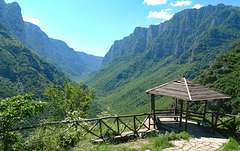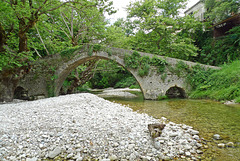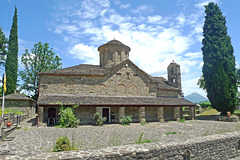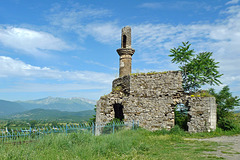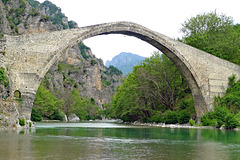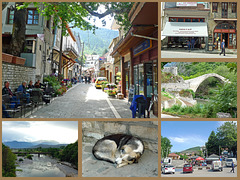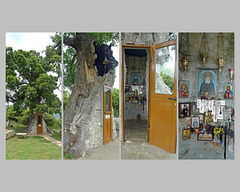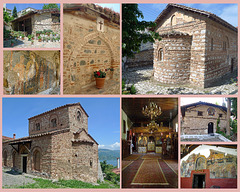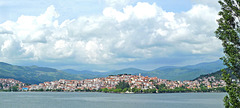Jaap van 't Veen's photos
Greece - Vikos Gorge
| |
|
|
|
The Vikos Gorge is located in the mountainous area of Epirus and is part of the Vikos-Aoos National Park. It is an extremely spectacular gorge due to its steep walls, rising to a height of more than 1.200 meters in several places. In fact, it is the second deepest gorge in the world, after the Grand Canyon in the USA. TheVoidomatis River crosses the Vikos Gorge and gives beautiful natural sceneries.
Although the Vikos Gorge has been called the 'deepest' gorge on earth (since 1997 it has been listed by Guinness World Records as the deepest canyon), it is not entirely true, as a special measurement method has been used that excludes other deeper places. Does not take away from the fact that the gorge is a downright natural wonder. The gorge was created because the river Voidomatis was given millions of years to erode it.
The gorge is named after the village of Vikos, where it ends. The starting point is about 600 meters after the mountain village of Monodendri. Its overall length exceeds 30km; its depth varies. In Monodendri it reaches 600 meters and is its the narrowest point and in Vikos village it reaches 1.200 meters. Vikos Gorge is nicknamed the “Grand Canyon of Greece”.
Greece - Vrosina, bridge
| |
|
|
|
Some pictures of the stone single-arched stone bridge in Vrosina. Its construction was funded by the Makralexis Monastery The bridge crosses the river Zaloggitikos just before it flows into the Kalamas.
I estimate the bridge is dating back to the end of the 19th century, like a lot of other stone bridges in Epirus. But to be honest I couldn’t find much information about the bridge. Even two friendly and helpful Vrosina-women were not able to find important information about its history on the internet.
Greece - Molyvdoskepastos, Church of the Holy Apos…
| |
|
|
|
The Church of the Holy Apostles is located just outside the small village of Molyvdoskepastos - known as Depalitsa until 1929. According to the text of the founding inscription, it was built in 1537 and the hagiographies were added in 1645. The church belongs to the cross inscribed architectural type, with a twelve-side dome, a narthes to the west and a later portico to the south. The interior shows remarkable frescoes.
The church used to be the seat of the Archbishop of Pogoniani until 1857. Next to the church is a viewpoint, from where there is a fine view of the area of the Greek-Albanian border and of the confluence of the rivers Aoos and Sarandaporos, the waters of the two rivers then cross the Albanian lands and flow into the Adriatic sea (PiP3).
Greece - Konitsa, Suleiman Mosque
| |
|
|
|
The Suleiman Mosque is the only surviving mosque in Konitsa. It is a building that Sultan Suleiman the Magnificent founded on his return from a campaign in Albania after 1536. It remains in a dilapidated state, after it was abandoned by the Muslim inhabitants of Konitsa, who left during the exchange of populations in 1925. It consists of a prayer area and the minaret which is built into the southwest corner of the prayer area.
On the same archaelogical site one will find also a hexagonal mausoleum of one room (PiP4) and the former Muslim school of Konitsa. According to an inscription on the lintel the school is dating back to 1869 (PiP5).
Greece - Konitsa Bridge
| |
|
|
|
The Konitsa or Aoos Bridge was built by architect and stone-master Zioga Frontzou. The construction – done by 80 craftsmen - was completed in 1870, after the first attempt collapsed a year earlier.. The bridge - built to replace an older wooden bridge that stoof on the same place - helped to improve communication and transport between the local population in the area. The construction of the bridge was a difficult and expensive undertaking and a miracle of its time. The bridge - professionally and aesthetically designed - was not only financed by the rich, but also by the ordinary people who shared the idea of the bridge.
The single-span stone arch bridge has a width of 36,80 meters and a height of almost 18 meters. The cobbled walkway - just 2,70 meters wide - has a length of 61,50 meters. The Konitsa Bridge is one of the largest stone bridges in Epirus (and even the Balkan).
It’s not only the bridge, but also the location with the Aoos river flowing under the arch and an incredible view into the Aoos Gorge with the natural beauty of the green mountains of the Northern Pindos National Park in the background.
Konitsa Bridge is built on the narrowest point of the Aoos gorge with some good rocks on both sides of the river. Therefore a one arch of big radius could steadily cover the distance, avoiding bigger and more expensive constructions. Under the arch hangs a little bell, which warned crossing people for strong winds. The bell was lost, but replaced in 1975.
Greece - Konitsa
| |
|
|
|
Konitsa, located near the Albanian border, is built amphitheatrically-shaped on a mountain slope of the Pindos mountain range from where it overlooks the valley where the river Aoos meets the river Voidomatis.
The town of Konitsa is recorded for the first time under its modern name in the “Chronicle of Ioannina” of 1380. The chronicle mentioned that the defences of the castle of Konitsa were strengthened by the local Despot of Epirus, due to an imminent attack. In 15th century Konitsa came under Ottoman rule. The town was the administrative centre of a kaza (Ottoman district), which according to the Ottoman General Census of 1881/82 had a total population of 16.570.
In 1924 Konitsa was a small town that consisted of a total of 800 dwellings, 200 of which were considered Albanian or Turkish. As a result of the population exchange agreement of 1923 between Greece and Turkey, roughly two-thirds of Konitsa's Muslims, were considered "Turks by origin" and left for Turkey in 1925. Another part moved to Albania. They were replaced with around 1,000 Greeks from Cappadocia.
There are different theories regarding the etymology of the name. The first states that the city takes its name from an ancient Epirote city named “Knossos”, which was located near modern-day Konitsa. Another theory states that the name is Slavic, from Koni (horse) and Tza (land). According to a third theory, the name comes from a local lord named Konis , who allegedly built a castle in the city.
Nowadays Konitsa is known to be one of the most beautiful villages of Greece. The well preserved stone houses harmoniously coexist with the cobblestone streets, the lush vegetation and gardens. The heart of the town is the main square with its cafes and terraces.
Greece - Agia Varvara, Saint Paisios tree church
| |
|
|
|
Nearby the hamlet of Agia Varvara one can find a unique tiny church, build in the trunk of a 300 year huge oak tree. This tree church is dedicated to Saint Paisios. It is believed that Saint Paisios, one of the most beloved figures in the Orthodox Church, passed through the area in his youth, going to nearby villages to carry out carpentry work and repairs in local houses.
The blessed tree had suffered severe destruction and fire, resulting in deteriorating condition. With each passing year, its condition worsened and there was a fear it might collapse. However , thanks to a local villager, the weak tree was internally shielded with local stone. A miracle happened and the tree has turned green again.
On the outside, there is a small bell, while on the inside, which only holds two people, there is a recess where the visitor can light his candle, a candelabrum, an icon of Christ, an icon of the Virgin Mary and in the center the icon of Saint Paisios.
Greece - Agia Anna, Tsouka waterfall
| |
|
|
|
The Tsouka waterfall is the only waterfall that has been created by the Stenorema brook, whose waters flow into the Aliakmon River. The waterfall - also called Agia Anna waterfall - is about 20 meters high and has a pond at its base. It is the largest of the regional unit of Kastoria.
We wanted to visit the waterfall from the Zoodochos Pigi church, which stands on the top of the cliff. Unfortunately, the path was closed due to restoration works on the church.
Greece - Kastoria, Monastery Panagia Mavriotissa
| |
|
|
|
The monastery Panagia Mavriotissa was founded in 1082/83 by Byzantine Emperor Alexios I Komnenos to commemorate the victory over the Normans and the recapture of Kastoria.
It is referred to in documents dating back to the 13th century as the monastery of Panagia Mesonisiotissa (= in the middle of the island). In the second half of the 17th century the name changed to Panagia Mavriotissa, because the inhabitants of the village of Mavrovo (nowadays ‘Mavrochori’) ensured that it remained in good condition.
The monastery played an important role in the history of the area, but remained closed for many years. It was reopened in 1998. Only a few buildings from the original monastery have survived. The church has a spacious narthex on the west side, which was added later. The interior is decorated with murals dating from the beginning of the 13th century. The icons on the outside date from the period 1259 - 1264.
The murals and drawings were damaged - all eyes of saints were removed - during Ottoman period. Some of these old frescoes were restored in the 13th century, while the outer wall of the narthex was decorated with new ones.
Greece - Lake Kremasta
| |
|
|
|
Lake Kremasta (or Lake Kremaston) is the largest artificial lake in Greece. It was formed as a result of the construction of Kremaston hydroelectric dam between 1961 and 1965. The water that is accumulated in the lake is about 3.8 cubic kilometers. The creation affected the lives of the residents as 15 villages would be found under the lake and that forced them to leave their homes and properties. Unfortunately the same goes for many historical bridges and churches.
The lake is continuously supplied by Acheloos, Agrafiotis, Tavropos and Trikeriotis rivers. The water of the lake penetrates along the beds of the four rivers and forms a lot of fjords and small islands. The artificial lake with its turquoise waters offers an incomparable Greek landscape.
Greece - Kastoria, (post)-Byzantine churches
| |
|
|
|
Kastoria is well-known for its churches. It is also calles “city of 100 churches”. The amount of Byzantine and post-Byzantine churches proves the richness of the city through the different ages. Kastoria originally had 72 Byzantine and medieval churches, of which 54 have survived. Some of them have been restored and provide useful insight into trends in late Byzantine styles of architecture and fresco painting.
Many of the churches are small structures, as they were built as private churches by wealthy fur traders or the katholika of small monasteries. They are either aisleless churches or three-aisled basilicas. Their façades often show rich masonry with decorative letters, geometrical patterns, bands of dentils and occasional sun motifs. The churches also have outstanding fresco decorations with diverse iconographic programmes, showing their donors’ and painters’.
Greece - Kastoria, Doltso
| |
|
|
|
In Ottoman times, Kastoria attracted a mass of people from all over the Balkans and beyond, resulting in a diverse, multi-ethnic community. The different ethnic communities, Bulgarian, Turkish, Greek and Jewish, were centred around separate neighbourhoods or 'quarters'. Two old lakeside Greek neighbourhoods "Doltso" and "Apozari" are among the best-preserved and last remaining traditional quarters of the city.
Especially “Doltso” - with its cobbled alleys and streets - is characterised by historic traditional mansions so called archontika - and houses, built between the 17th and 19th centuries by wealthy Kastorian furriers. During this time, the processing and exporting of animal furs created wealth in Kastoria.
Some of these mansions nowadays houses museums and hotels.
Greece - Kastoria
| |
|
|
|
Kastoria is partly built on a narrow peninsula jutting into Lake Orestiada at an altitude of about 620 meters. The small city is tucked away in the mountains of Macedonia. The place was first mentioned in the 1st century AD of a town near a lake called Celerum, a town which was captured by the Romans during their war against Phillip V of Macedonoa in 200 BC.
The name Kastoria was first referred to in the late 10th century, when it was held by Bulgaria during the Byzantine-Bulgarian wars. Most probably Kastoria derives from the Greek word kástoras , meaning beaver.
Trade in the fur was traditionally an important element of Kastoria’s economy. The trade in beaver skins, which began over a thousand years ago, gave rise to the town’s chief industry. When the beavers from the lake ran out, the town imported furs. Nowadays the fur trade has almost stopped.
Kastoria is well known for its many Byzantine churches and monasteries. From the 72 Byzantine and medieval churches there are still more than fifty in and around the city. Many of them have frescoes that are in very good shape. One of the most beautiful and interesting is Monastery Panagia Mavriotissa, located on the shores of Lake Orestiada.
Lake Orestiada (or Lake Kastoria), the promenade and forests offer a perfect shelter for all kind of bird species. The lake is home for 200 different species, among them some rare and endangered ones. The most typical species are cormorants, pelicans, herons, swans, wild ducks and herons. Lake and surrounding wetlands also house frogs and Greek turtles.
Greece - Siatista, Holy Church of Saint Paraskevi
| |
|
|
|
The Holy Church of Saint Paraskevi (Agia Paraskevi) is a great example of post-Byzantine architecture. The church was built in 1677, in the shape of a domed three-aisled basilica. The hexagonal bell tower with a height of 25 meters was added in 1862. The building - a most precious monument of Byzantine art - dominates the central square of Geraneia district, one of the two city quarters.
The church is considered being the most impressive of the years of the Turkish occupation in western Macedonia. The interior shows exquisite icons, a gilded wood-carved iconostasis and a gold plated pulpit. The stone built church, with oak transoms and beams, small windows, in Basilica order, is full with frescoes and precious icons.
Greece - Siatista, Poulko Mansion
| |
|
|
|
The Poulko Mansion (also called Poulkidis Mansion) is located in the Geraneia neighbourhood in Siatista. According to an inscription over the entrance, its construction began in 1752 and probably completed in 1759. The building was commissioned by Theódoros Emmanouilídis, an Ottoman-era merchant from the town, and later purchased by tobacco merchant Lázaros Poúlkos (or Poulkídis).
The mansion consists of a semi-buried ground floor and two upper floors overlooking a courtyard that includes an oven, a cistern and a garden. The ground floor was used for storage. The first floor was used as the family's winter residence, with bedrooms featuring fireplaces and cupboards richly decorated with frescoes. The top floor had the same layout as the middle floor and was used as a summer residence.
The Poulko Mansion - a precious example of upper middle class daily life in 18th century western Macedonia - shows excellent decorative painting, stained glass windows and wood carvings. The plaster decorations on the mansion’s fireplaces are of amazing artistry. Its facade, in the section just under the roof, is decorated with stylized ornamental motifs (rosettes, stars) and a ship.
After a restoration the Poulko Mansion - a juwel of the small city of Siatista - is open to the public again
Greece - Veria, Monastery of Timios Prodromos
| |
|
|
|
The monastery of Timios Prodromos (Saint John the Baptist) is the most important of the monastic settlements ('sketai') in the area around Veria. The historic stone monastery has been operating since the 14th century. Known as the “Skete of Veria”, as the monastery was built in a Holy Skete that existed on the site since the 9th-10th century.
The monastery was set on fire in 1822 by the Ottomans. The only structure that survived was the chapel of the Transfiguration of the Savior. In 1835 the monks rebuilt the cells, the new katholikon and a good part of the fortified wall; at this point the monastery assumed then the form it has today.
Remains of several Saints are kept in the Monastery, while visitors can admire many works of hagiographic art, some of which have been saved from the period before the destruction of 1822. Its katholikon is also remarkable, in the type of the three-aisled basilica, with magnificent columns made of trunk trees and imposing images.
Timios Prodromos is located at the verdant foothills of Pieria mountains, with an imposing view of the artificial lake of the Aliakmonas river; a fascinating landscape created by the river with the dense forests. The impressive entrance with the large, wooden medieval gates, the stone fountain, the relief of the buildings as they join the slope and the fresh air give visitors a warm welcome.
Greece - Palatitsia, Church of Saint Demetrius
| |
|
|
|
The church of Saint Demetrius (Agios Demetrios) is dating back to the year of 1570. It has been rebuilt with materilas from the royal palace of Philip II in Agaai, at the location of a Byzantine cemetery in the 16th century. The three-nave basilica is characterized by its lavish wall paintings made by a group of hagiographers from Lianotopi Kozani, the origin of famous hagiographers of that time. Shortly after its erection in 1591 a spacious narthex was added to the church.
Rich interior decoration, with rare wall paintings, is added to the admirable architectural design of the structure and the refined construction. Half of the wall paintings were created by Nicholaos Zografos and “narrated” the life of Christ and Saint Demetrios, portrayed saints, prophets and martyrs of the Church, the Assumption of the Theotokos and the Platytera of Heaven. The rest of the wall paints, which belong to an unknown artist, depict the Last Judgment while among the figures of the triumphant and victorious stands Alexander the Great. This is a rare presentation of high aesthetics and great historical value. Some parts of the wooden iconostasis are preserved intact.
The Church of Saint Demetrius, which is designated as a monument by UNESCO, remained closed and deserted for decades, until 2017 when its restoration and maintenance were approved. Nowadays the church is open to the public.
The Church of Saint Demetrius is a real hidden gem. It is tucked away completely outside the little village of Palatitsia behind a cemetery. We were fortunately welcomed by a caretaker, who also opened the church and lit the lights.
Greece - Veria, Old Metropolis
| |
|
|
|
The Old Metropolis/Cathedral of Veria (officially transliterated Veroia) is one of the largest mid-Byzantine in the Balkans, which was erected between 1070 and 1080 by Nikitas, the then bishop of the city. It is an architectural masterpiece of three aisled basilicas with a timber roof. This impressive church shows the prosperity of the town during the middle Byzantine period. The church was dedicated to Saint Paul. During the Ottoman period of the city it became an Ottoman mosque (Hünkar Mosque).
The distinctive features that bring added uniqueness, specific architectural, artistic and historical value to the Old Cathedral is the incorporation of early Christian templates that gives the impression of a premier temple compared with the relevant monuments of the same period, as well as the wall painting decoration that presents some of the greatest painting works of the 12th, 13th and 14th century. For this reason it is regarded as the gem of Byzantine Veria.
After the completion of the restoration works in 2016, the church is accessible to the public again, offering a unique tour of the Byzantine history of Veria.
Jump to top
- ipernity © 2007-2024
- Help & Contact
|
Club news
|
About ipernity
|
History |
ipernity Club & Prices |
Guide of good conduct
Donate | Group guidelines | Privacy policy | Terms of use | Statutes | In memoria -
Facebook
Twitter

